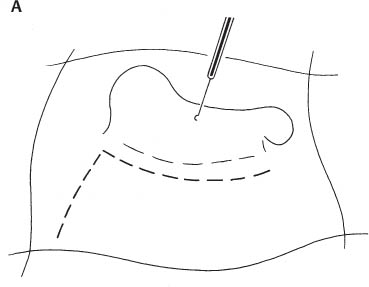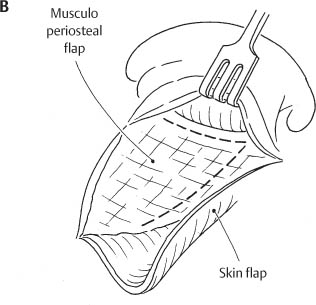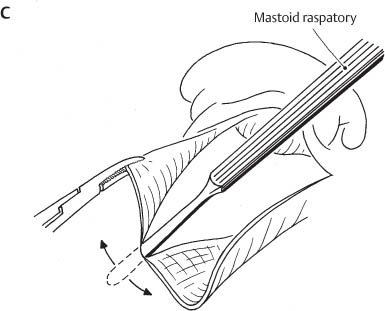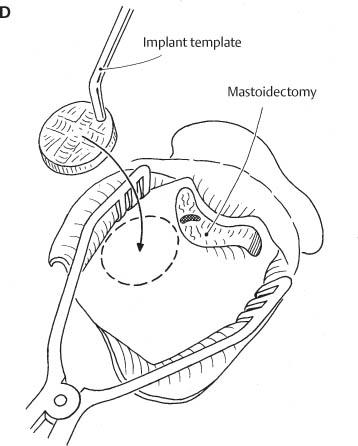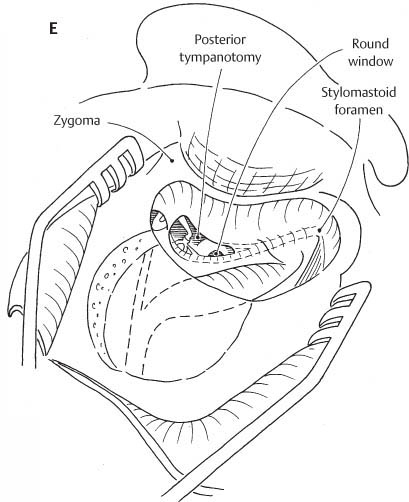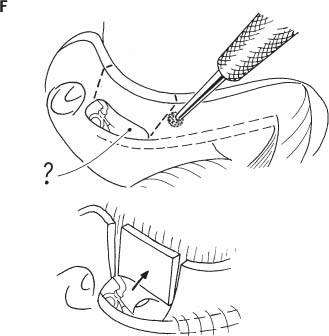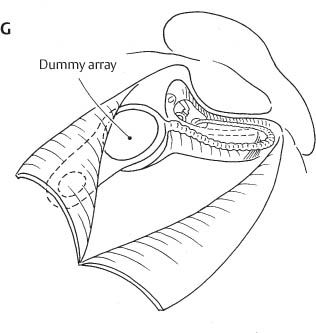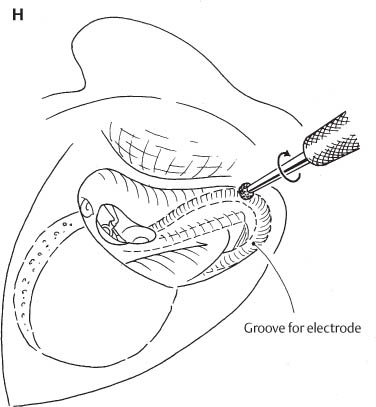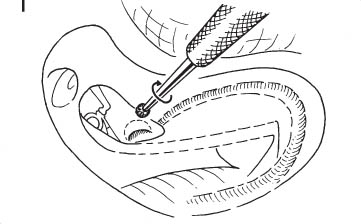Chapter 6 Special Applications of Mastoidectomy The indication for the reconstruction of a properly performed open cavity is rarely given because the wide lateral removal of bone and the posterior obliteration of the cavity with occipital myosubcutaneous flap will produce small cavities with an average volume of 1.5 ml. The reconstruction of an open cavity may be associated with — a ventilated mastoid (Figs. 104A and B) or — an obliterated mastoid (Fig. 104C). The principles of the various types of reconstruction are shown in the following figures. Reconstruction of a ventilated mastoid is seldom performed because, in the long term, the eustachian tube problems that have created the initial disease often manifest themselves again (Chapter 10, pp. 299–300). Fig. 104A Autogenous bone from the retroauricular region and from the temporal squama (see Figs. 55A–F) is used to reconstruct the posterior wall in association with homograft ossicles. This type of reconstruction has been disappointing in the long term because of recurrent disease induced by defective ventilation in the attic and mastoid with poor functional results. Fig. 104B The attempt to reconstruct a ventilated mastoid in association with an ossicular bypass of the attic has also proven unsuccessful in the long term (see Fig. 57). It is probably too optimistic to expect complete reepithelization of a ventilated attic and mastoid from a minimal mucosal lining confined to the protympanum. Fig. 104C Obliteration of the mastoid with autogenous bone paste (bone dust mixed with fibrin glue) has been more successful than attempts to reventilate the mastoid and attic. However, partial breakdown of the reconstructed meatal wall may occur in time, producing irregularities that limit the self-cleansing property of the cavity. This change in the shape of the cavity may also induce the danger of retention cholesteatoma. This is why, before reconstruction, the bony cavity should be shaped as an open mastoido-epitympanectomy with tympanoplasty. This implies the extensive removal of lateral tympanomastoid bone and adequate meatoplasty. At present we prefer to fill the mastoid with an occipital myosubcutaneous flap (as described on pp. 193–195, Figs. 98C and D) and to incorporate the attic in the open cavity. Since 1994 we have used a minimal posterior skin incision in conjunction with a subperiosteal pouch for the implantation of a cochlear implant (Fisch U. 1994, 22-R). This technique, which requires no more exposure of the retroauricular region than for a mastoidectomy, has been used successfully for over 10 years. The described surgical steps relate to the implantation of all current implants. The main differences are in the shape and depth of the implant bed, whereas the anterior mastoidectomy and cochleostomy are the same for all implant types. The operation is carried out under general anesthesia.
 Reconstruction of an Open Cavity
Reconstruction of an Open Cavity
 General Concepts
General Concepts
 Surgical Technique
Surgical Technique
Reconstruction of open cavity with ventilated mastoid, using autogenous bone and drum
Reconstruction of open cavity with ventilated mastoid, using autogenous bone and fascia
Reconstruction of open cavity with an obliterated mastoid
 Cochlear Implant
Cochlear Implant
 Surgical Technique
Surgical Technique
Surgical Highlights |
|
Surgical Steps
Fig. 105A
Skin incision
The L-shaped retroauricular skin incision; the longer limb is close to the retroauricular sulcus and the shorter limb is along the temporal line.
Fig. 105B
Musculoperiosteal flap
A reverse L-shaped incision is used for the musculoperiosteal flap, which is based superiorly in contrast to the skin flap. The anterior limb of the incision is made as close as possible to the entrance of the external ear canal. In this way, the skin and periosteal incisions do not overlie each other. The inferoposterior limb of the incision is made just long enough to permit the exposure of bone necessary to drill the bony bed for the receiver/stimulator package. The parietosquamous periosteum posterior to the bony bed is elevated to allow placement of the magnet/antenna portion of the implant. Since this pouch will fix the implant, the posteroinferior limb of the periosteal flap has to remain as short as possible.
Fig. 105C
Elevation of the parietosquamous periosteum
The periosteum is elevated from the bone posterosuperiorly to stabilize the flange of the implanted receiver/stimulator package. The mastoid raspatory (13-I) should remain on bone during this procedure to keep the periosteum intact and prevent bleeding. The elevation should not exceed the size of the flange of the implant.
Fig. 105D
Beginning the mastoidectomy and bed for receiver/stimulator package
The mastoid and antrum are identified. A template is used to determine the location and size of the bed to be drilled behind the sinodural angle. The shape depends on the implant type. The depth is determined by the thickness of the bone. The dura should always be covered by a thin layer of bone (skeletonized) and not be exposed. A partial anterior mastoidectomy is performed, skeletonizing the sigmoid sinus, and the digastric muscle is exposed within the mastoid tip.
Fig. 105E
Anterior mastoidectomy and posterior tympanotomy
The anterior mastoidectomy consists of exenterating the mastoid cells behind the posterior canal wall. When sufficient exposure is reached over the expected course of the facial nerve, further removal of air cells is not necessary. The antrum is exposed for identification of the lateral canal and short process of the incus. The bed for the receiver/stimulator package is drilled posterosuperior to the confluence of the superior petrosal and sigmoid sinuses, allowing enough space for the anterior mastoidectomy and accommodation of the external speech processor behind the ear. The stylomastoid foramen is identified along the digastric ridge and stylomastoid periosteum (see Figs. 80H and 91A–D). The mastoid segment of the facial nerve is skeletonized in a retrograde fashion to the level of the posterior semicircular canal. The posterior tympanotomy is carried out between the progressively skeletonized pyramidal segment of the facial nerve and the chorda tympani. Knowledge of the location of the facial nerve eliminates the risk of accidental injuries (heat and burr) and allows large inferior exposure of the round window niche (see also Fig. 80M). EMG monitoring of the facial muscles (NIM-2) is used for this preparation.
An alternative way to perform the abovementioned steps is to complete the anterior mastoidectomy and posterior tympanotomy first and drill the bony bed for the implant last.
Fig. 105F
Introduction of the cochlear implant
The final position of the cochlear implant is tested with a dummy array, which includes the electrode lead. In this way, the position of the bony groove in the mastoid for the electrode lead is determined.
Fig. 105G
Mastoid groove for electrode fixation
A bony groove is drilled along the inner surface of the mastoid tip and posterior canal wall to stabilize the electrode. This removes the need for the complicated Dacron mesh ties described in the literature.
Fig. 105H
Cochleostomy
The mucosa over the promontory is coagulated using fine bipolar angulated forceps to prevent bleeding while drilling. The superior rim of the round window niche is identified and the cochleostomy starts with a 1-mm diamond drill on low speed. The superior rim of the round window may be removed until the whitish membrane of the basal turn is exposed. In narrow mastoids the cochleostomy starts slightly anteriorly to the round window niche and is directed slightly inferiorly. High-resolution computed tomography (CT) scans are helpful to determine the amount of ossification and the thickness of the otic capsule over the lumen of the basal turn. The cochleostomy should be large enough to allow easy insertion of the electrode array. Any bony rims should be smoothed to prevent blockage of the electrodes during insertion. The scala tympani is opened using a 0.5-mm hook (27-I). Suctioning of the perilymph should be avoided. In case of complete ossification of the basal turn, the electrodes may be placed in the scala vestibule following removal of the stapes. If the entire cochlea is ossified, a new canal for the electrode is drilled around the modiolus under direct vision. This requires conversion of the access into a subtotal petrosectomy (See Fig. 105O).
Fig. 105I
Introduction of the electrodes in the scala tympani
Using watchmaker forceps (10-I) the tip of the electrode array is placed in the 1–2-mm opening drilled in the basal turn. The electrodes are then advanced inside the scala tympani with a special claw for electrode insertion (provided by Cochlear 74-I) or with watchmakers forceps (10-I)
Stay updated, free articles. Join our Telegram channel

Full access? Get Clinical Tree


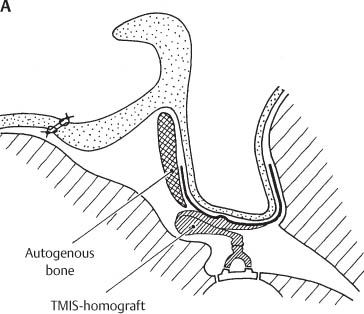
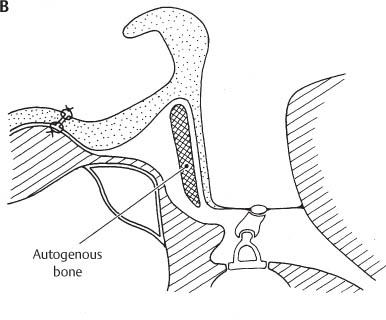
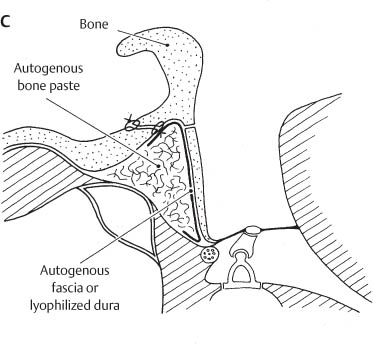
 L-shaped retroauricular incision for skin flap.
L-shaped retroauricular incision for skin flap. Inverted L-shaped incision for musculoperiosteal flap.
Inverted L-shaped incision for musculoperiosteal flap. Bed for the receiver/stimulator package drilled behind the sinodural angle.
Bed for the receiver/stimulator package drilled behind the sinodural angle. Partial anterior mastoidectomy.
Partial anterior mastoidectomy. Retrograde exposure of mastoid segment of fallopian canal.
Retrograde exposure of mastoid segment of fallopian canal. Posterior tympanotomy with exposure of round window niche.
Posterior tympanotomy with exposure of round window niche. Formation of mastoid groove for the electrode lead.
Formation of mastoid groove for the electrode lead. Placement of receiver/stimulator package in its bony bed and fixation under parietosquamous periosteal pouch.
Placement of receiver/stimulator package in its bony bed and fixation under parietosquamous periosteal pouch. Introduction of electrode array into basal turn of cochlea.
Introduction of electrode array into basal turn of cochlea. Placement of electrode lead in its bony groove.
Placement of electrode lead in its bony groove. Wound closure in layers.
Wound closure in layers.